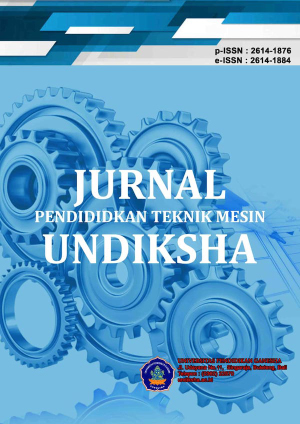Analisa Keausan Kampas Rem Sepeda Motor Berbahan Komposit Serbuk Tempurung Buah Maja
DOI:
https://doi.org/10.23887/jptm.v10i1.44431Abstract
Pemanfaatan serbuk tempurung buah maja terbilang masih belum maksimal. Kampas rem komposit saat ini banyak dikembangkan karena sifatnya yang ramah lingkungan dan tahan panas dibandingkan kampas rem non asbestos. Penelitian ini bertujuan untuk menganalisis fraksi volume serbuk tempurung buah maja terhadap keausan komposit bermatrik epoxy sebagai material alternatif kampas rem sepeda motor. Desain penelitian ini menggunakan true experimental design dengan tipe posttest-only design, terdapat kelompok eksperimen (komposit) dan kelompok kontrol (kampas rem merk Indoparts). Hasil penelitian menunjukkan nilai yang paling optimal terdapat pada volume 30% dengan nilai keausan 2,008 x 10-6 mm2/kg. Hal itu menunjukkan semakin banyak volume serbuk, maka kekuatan komposit akan meningkat. Nilai tersebut yang paling mendekati dengan nilai kampas rem sepeda motor merk Indoparts. Maka dari itu, komposit serbuk tempurung buah maja dapat direkomendasikan sebagai material alternatif kampas rem sepeda motor.
Kata kunci: fraksi volume; keausan; kampas rem; serbuk tempurung buah maja.
The utilization of wood apple shell particles is not optimal yet. Composite brake pads are currently being developed because they are eco-friendly and heat resistant compared to non-asbestos brake pads. This research attempt to analyze the volume fraction of Buah maja shell particles on the measure of wear from epoxy matrix composites as an alternative material for motorcycle brake pads. The design of this research uses a true experimental design with a posttest-only design type, there is an experimental group (composite) and a control group (Indoparts brand brake pads). The results show the most optimal measure is found in volume 30% with a hardness measure of wear 2,008 x 10-6 mm2/kg. It shows that the more particles volume, the composite strength will increase. This measure is closest to the measure of the Indoparts motorcycle brake pads. Therefore, wood apple shell particles composite can be recommended as an alternative material for motorcycle brake pads.
Keywords : Buah maja shell particles ; Brake pads; Volume fraction; Wear.
DAFTAR RUJUKAN
Ademoh, N. A., & Olabisi, A. I. (2015). Development and evaluation of maize husks (asbestos-free) based brake pad. Development, 5(2), 67-80.
Afolabi, M., Abubakre, O. K., Lawal, S. A., & Raji, A. (2015). Experimental investigation of palm kernel shell and cow bone reinforced polymer composites for brake pad production. International Journal of Chemistry and Materials Research, 3(2), 27-40.
Atmika, I. K. A., Subagia, I. D. G. A., Surata, I. W., & Sutantra, I. N. (2019, June). Hardness and wear rate of basalt/alumina/shellfish powder reinforced phenolic resin matrix hybrid composite brake lining pads. In IOP Conference Series: Materials Science and Engineering, 539(1), 012012.
Elanchezhian, C., Ramnath, B. V., Ramakrishnan, G., Rajendrakumar, M., Naveenkumar, V., & Saravanakumar, M. K. (2018). Review on mechanical properties of natural fiber composites. Materials Today: Proceedings, 5(1), 1785-1790.
Gbadeyan, O. J., Kanny, K., & Mohan, T. P. (2017). Influence of the multi-walled carbon nanotube and short carbon fibre composition on tribological properties of epoxy composites. Tribology-Materials, Surfaces & Interfaces, 11(2), 59-65.
Kiran, Z. S., Babu, V. S., & Shekar, K. S. (2019). Study of the microhardness and erosive wear behavior of organo-modified nanoclay filled glass-epoxy composites and optimization. Journal of Mechanical Engineering and Sciences, 13(2), 4794-4815.
Liao, Z., Hua, N., Chen, W., Huang, Y., & Zhang, T. (2018). Correlations between the wear resistance and properties of bulk metallic glasses. Intermetallics, 93, 290-298.
Maleque, M. A., Atiqah, A., Talib, R. J., & Zahurin, H. (2012). New natural fibre reinforced aluminium composite for automotive brake pad. International journal of mechanical and materials engineering, 7(2), 166-170.
Prasad, L., Singh, G., & Pokhriyal, M. (2018). A comparative study on physical and mechanical behaviour of functionally graded composite materials reinforced with natural fillers. Materials Today: Proceedings, 5(9), 16990-16994.
Sahari, J., Sapuan, S. M., Zainudin, E. S., & Maleque, M. A. (2013). Mechanical and thermal properties of environmentally friendly composites derived from sugar palm tree. Materials & Design, 49, 285-289.
Sastry, M. N. P., Devi, K. D., & Bandhu, D. (2016). Characterization of Aegle Marmelos fiber reinforced composite. International Journal of Engineering Research, 5(SP 2), 345-349.
Sathish, S., Kumaresan, K., Prabhu, L., & Gokulkumar, S. (2018). Experimental investigation of mechanical and FTIR analysis of flax fiber/epoxy composites incorporating SiC, Al2O3 and graphite. Revista Romana De Materiale, 48(4), 476.
Satikbaša, K., Selvakumar, A. S., Sal, B., & Surja, R. B. (2019). Effect of steel family fibers on friction and stiction behavior of brake pads. FME Transactions, 47(4), 856-864.
Shakuntala, O., Raghavendra, G., & Acharya, S. K. (2018). Characterization of Wood Apple Shell Particles. In Conference Proceedings of the Second International Conference on Recent Advances in Bioenergy Research. Springer, 139-146.
Shinde, D., & Mistry, K. N. (2017). Asbestos base and asbestos free brake lining materials: Comparative study. World Scientific News, 61(2), 192-198.
Soenoko, R., Suprapto, W., & Irawan, Y. S. (2020). Characterization of aluminium matrix composite of Al-ZnSiFeCuMg alloy reinforced with silica sand tailings particles. Journal of Mechanical Engineering and Sciences, 14(3), 7094-7108.
Downloads
Published
Issue
Section
License

Jurnal Pendidikan Teknik Mesin Undiksha is licensed under a Creative Commons Attribution-ShareAlike 4.0 International License.









